The twenty-ninth day of songs in this series.
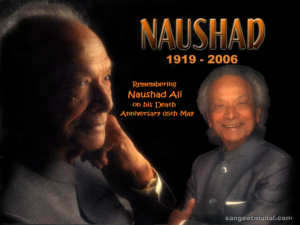 Three days ago was the death anniversary of one of the greatest music directors that India saw: Naushad Ali. Naushad was the second (after Pankaj Mullick) of the music directors to be awarded the highest honour in Indian Cinema: the Dadasaheb Phalke Award, in the year 1981. Since then, no other music director has been so honoured.
Three days ago was the death anniversary of one of the greatest music directors that India saw: Naushad Ali. Naushad was the second (after Pankaj Mullick) of the music directors to be awarded the highest honour in Indian Cinema: the Dadasaheb Phalke Award, in the year 1981. Since then, no other music director has been so honoured.
As far as I am concerned, everything that my favourites: lyricist Shakeel Badayuni wrote, Naushad Ali composed, Mohammad Rafi sang and Dilip Kumar enacted tugs at my emotions. That’s why my blog has more than 15 posts dedicated to Shakeel and most of these are with Naushad, his guide and mentor. Indeed, in my ‘The Best Of Old Hindi Songs – Rafi, Shakeel, Naushad and Dilip Kumar Together’, I had brought out the magic that ensues when the quartet was together. In my ‘Songs That Tug At Your Emotions – Song #14’ I had given the first ever song that Shakeel penned in Hindi movies (a song that was sung by Uma Devi (Tun Tun) on a composition by Naushad): Afsaana likh rahi hoon dil-e-beqraar ka. This was for the 1947 Abdul Kardar movie: Dard. Shakeel’s last song with Naushad was for the 1968 A Bhimsingh movie Aadmi: Na aadmi ka koi bharosa.
In the last twenty-eight days, we have taken up songs of thirteen male singers: Talat Mahmood, Manna Dey, Kishore Kumar, Mohammad Rafi, Mukesh, Hemant Kumar, Mahendra Kapoor, SD Burman, KL Saigal, Pankaj Mullick, Jagmohan ‘Sursagar’, Hariharan and Yesudas. We also took up songs of eleven female singers: Lata Mangeshkar, Asha Bhosle, Suman Kalyanpur, Shamshad Begum, Geeta Dutt, Uma Devi (Tun Tun), Suraiya and Zohrabai Ambalewali, Sudha Malhotra, Amirbai Karnataki and Kavita Krishnamurthy. We took up a duet between Mohammad Rafi and Asha Bhosle in the last post. And lastly we took up a Talat Mehmood song: Phir wohi shaam wohi gham wohi tanhaayi hai. After that, on the twenty-sixth day we took up a Kishore Kumar song for Piya Ka Ghar: Ye jeevan hai. The twenty-seventh post was devoted to Shankar Jaikishan Foundation’s Mumbai Meet with the Lata Mangeshkar and Manna Dey song from Raat Aur Din: Dil ki girah khol do. The twenty-eighth post was devoted to Majrooh-Laxmikant Pyarelal-Rafi song: Chahunga main tujhe saanjh savere for the 1964 Satyen Bose movie: Dosti.
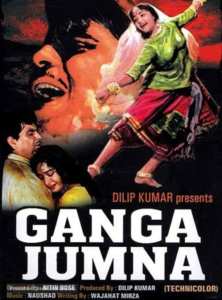
Today’s song is from one of the most popular movies that the quartet attempted together: the 1961 movie Gunga Jumna, written and produced by Dilip Kumar (another Dadasaheb Award winner and holding the record (now jointly with Shah Rukh Khan) for highest number of Filmfare Awards. He holds the Guinness World Record for the highest number of awards won by an Indian actor). The movie was directed by Nitin Bose and starred Dilip Kumar and Vyjayanthimala in the lead roles. She won the Best Actress award for the movie whereas Dilip Kumar lost to Raj Kapoor for his role in Jis Desh Mein Ganga Behati Hai (Another Ganga movie!), a move criticized by The Hindu.
The film starred the brothers Dilip Kumar (Muhammad Yusuf Khan) and Nasir Khan as Gunga and Jumna. Many people regard this as the best role ever played by Dilip Kumar. Amitabh Bachchan is on record saying that he tailored his own acting after watching Dilip Kumar in Gunga Jumna. The Hindu, therefore, called it a travesty of justice that one of the finest performances ever in Indian Cinema wasn’t rewarded by Filmfare. What was so special about the performance. Besides the rustic image that Dilip Kumar perfected, his dacoit role (when he is forced to become one in the end) inspired many others in the movies. “Bachchan, who hails from Uttar Pradesh, was particularly impressed by Dilip Kumar’s mastery of the Awadhi dialect, expressing awe and surprise as to how a man who’s not from Allahabad and Uttar Pradesh could accurately express all the nuances of Awadhi.”
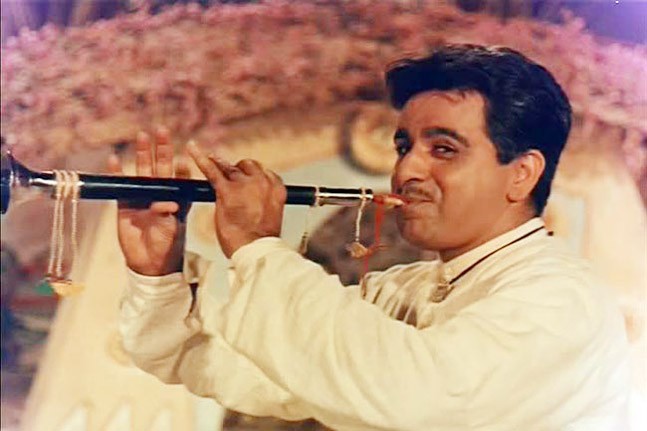
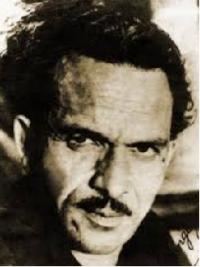
Gunga Jumna’s dialogues were penned by Wajahat Mirza who had penned the same for Mughal-e-Azam one year ago and won Filmfare Award. He won for this movie too. We must remember that dialogues and lyrics played important roles in popularity of films at that time and both were penned by the best in their profession. Both were Urdu speaking and mastered Awadhi in this movie. We have only mentioned the men. However, please think of the lady who won the Best Actress Award: Vyjayanthimala. She was from the South, a fashion model, and yet her portrayal of Dhanno, a rustic girl, speaking fluently in Bhojpuri, would be nothing short of sterling performance.
The one song in the movie that brings out the best in all the personae that I have mentioned so far is the song that I have decided to give today: Nain lad jainhe to manva mein kasak hoibe kari. Lets go over them one by one:
-
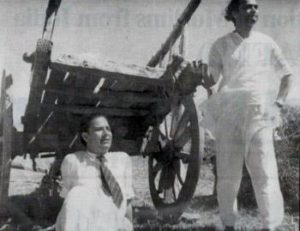
Shakeel with Naushad in rustic surroundings. Shakeel Badayuni. He was at his best at that time and created a record by being the only Lyricist ever to have done a hat-trick of winning the Best Lyricist awards for three consecutive years. He had mastered the Urdu poetry and lyrics and here in this song he proved his mettle at writing in Awadhi. If you pay attention to the lyrics (I am giving an example below), you’d notice that it is not just the language; it is a deep understanding of the mores of that area:
आँख मिल गयी है सजनिया से तो नाचन लगी है
प्यार की मीठी गजल मनवा भी गावन लगी है
झाँझ बजी है तो कमरिया म लचक होइबे करी
- Naushad Ali. He was the best in many aspects. However, when it came to folk based tunes (such as in Baiju Bawra), he had no peers. Some of the songs that come to mind are: Aaj mere man mein sakhi bansuri bajaye (Aan), Door koi gaaye dhun ye sunaaye (Baiju Bawra), Chhod babul ka ghar mohe pi ke nagar aaj jaana padha, Panchhi ban mein piya piya gaane laga (Babul), Dukh bhare din beete re bhaiya, Gaadi waale gaadi dheere haank re, Holi aayi re Kanhaai, Matwaala jiya bole piya (all from Mother India), and Mere pairon mein ghungru bandha de (Sunghursh). In this song, the kind of folksy atmosphere that he has created is simply adorable.
-
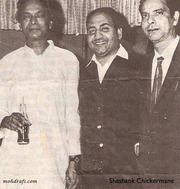
Naushad, Rafi and Shakeel together Mohammad Rafi. For most genre of songs, Mohammad Rafi was simply the best that we ever had. Whilst all other playback singers sang with their characteristic styles, Mohammad Rafi went beyond and sang in the style of the actor for whom he was singing. In this song, for example, never do you get the impression of Rafi singing; the song is just an extension of Dilip Kumar’s acting as Gunga in the movie. If Dilip Kumar mastered the Awadhi in the movie, Mohammad Rafi – as far from Awadhi as you can get – made it look like as if he was brought up singing such songs.
- Dilip Kumar. The hallmark of a great actor is to let you forget his own personna but make you think of the role that he is portraying. Dilip Kumar’s performance in this song is seamless and flawless. It is as if the song was written, composed and sung for him. You can’t even imagine anyone else enacting this song.
- Vyjaynthimala. She is the one who walked away with the Best Actress Award. In this song, she makes her appearance very briefly first in the prelude when she sits next to a diya and thinking of him and in the end when he has finished dancing with all the other belles and returns to the focus of his life: Dhanno. Those brief moments of histrionics are enough to leave an impact. Of course, she is only enjoying his singing and dancing. Later in the movie when she dances on Dhoondo dhoondo re saajana, she is like rhythm in motion.
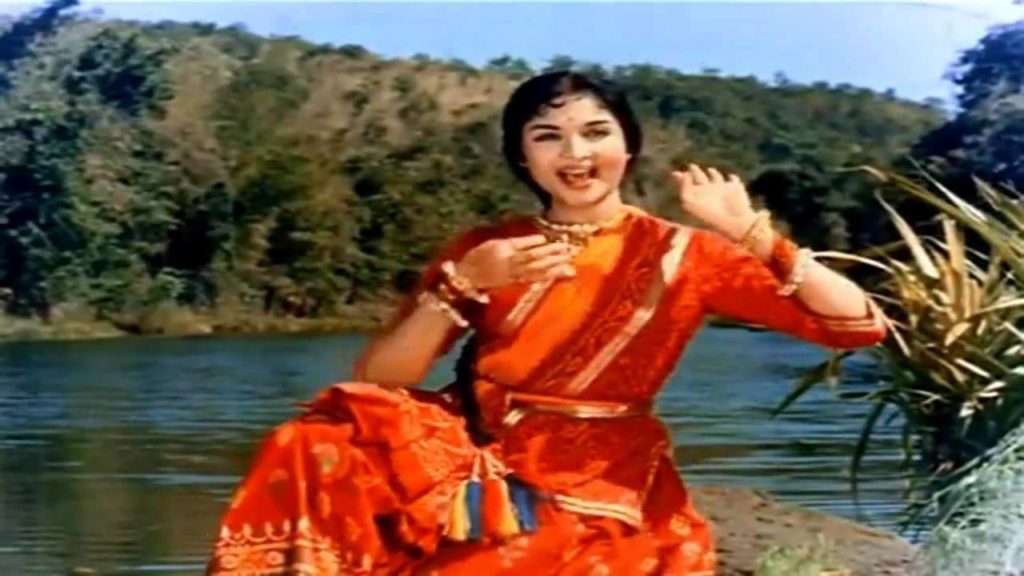
- Nitin Bose. There is hardly anyone who hasn’t heard of Nitin Bose. The first use of playback singing in Indian movies occurred in 1935 Bengali movie Bhagya Chakra. The same year, the movie was made in Hindi as Dhoop Chhaon. Bose started his film career as a cinematographer in 1926 in the movie Punarjanma. His debut as cinematographer under New Theatres banner was in the movie Devdas (1928). He was cinematographer of the only film directed by Rabindranath Tagore, Natir Puja (1932), which was based on a dance-drama composed by Tagore. The great Satyajit Ray was a nephew of Nitin Bose and worked under him for Mashaal (1950). In this movie and the song, Nitin Bose seem to have perfected the village setting to such an extent that it was copied in many other movies. The sight of a village teacher (Abhi Bhattacharya) teaching the children (Insaaf ki dagar pe bachcho dikhao chal ke) has also been copied in many other movies. Nitin Bose won the Dadasaheb Phalke Award four years before Dilip Kumar did.
Before we take up the song, let’s have a look at the other songs in the movie put together by Shakeel and his mentor Naushad:
| 1 | Dagabaaz Tori Batiyan | Lata Mangeshkar | 2:47 |
| 2 | Dhoondo Dhoondo Re Sajna | Lata Mangeshkar | 3:19 |
| 3 | Do Hanson Ka Joda | Lata Mangeshkar | 3:14 |
| 4 | Jhanan Ghoongar Baje | Lata Mangeshkar | 3:32 |
| 5 | Naina Lad Jaihen | Mohammed Rafi | 4:44 |
| 6 | O Chhalia Re Chhalia | Mohammed Rafi, Asha Bhosle | 3:30 |
| 7 | Tora Man Bada Papi | Asha Bhonsle | 4:41 |
| 8 | Insaaf Ki Dagar Pe | Hemant Kumar | 3:20 |
| 9 | Naina Lad Jaihen (Revival) | Mohammed Rafi | 4:46 |
Please enjoy Mohammad Rafi sing a composition of Naushad Ali on the lyrics of Shakeel Badayuni, a song from the 196i Nitin Bose movie Gunga Jumna: Nain lad jainhe to manva kasak hoibe kari….
लागा गोरी गुजरिया से नेहा हमार
होइ गवा सारा चौपट मोरा रोजगार
ओ~
नैन लड़ जैंहे तो मनवा में कसक होइबे करी
प्रेम का छुटि है पटाखा तो धमक होइबे करी
नैन लड़ जैंहे …
रूप को मनमा बसैबा तो बुरा का होई है
तोहू से प्रीत लगैबा तो बुरा का होई है
प्रेम की नगरी म कुछ हमरा भी हक़ होइबे करी
नैन लड़ जैंहे …
होई गवा मन मा मोरे तिछर्ई नजर का हल्ला
गोरी को देखे बिना निंदिया न आवै हमका
फाँस लगी है तो करेजवा म खटक होइबे करी
नैन लड़ जैंहे …
थैक थैक थै थै, थै
धाक धिनक धिन, ताक तिनक तिन
धाक धिनक धिन, धाक धिनक धिन, धा!
आँख मिल गयी है सजनिया से तो नाचन लगी है
प्यार की मीठी गजल मनवा भी गावन लगी है
झाँझ बजी है तो कमरिया म लचक होइबे करी
नैन लड़ जैंहे …
नैना जब लड़ी है तो भैय्या मन में कसक होइबे करी
थैक थैक तिक था
होय होय होय!
मन ले गयी रे धोबनिया रामा कैसा जादू डार के
कैसा जादू डार के रे, कैसा टोना डार के
मन ले गयी रे धोबनिया रामा कैसा जादू डार के
मन ले गयी रे धोबनिया रामा कैसा जादू डार के
It is not just because of the principal people involved in the making of the song that make this song tug at your emotions. The song fills you with nostalgia of the era that was there when we were small. When melody ruled, when folks were simple, when what we saw on the screen was a reflection of the society that existed with all its good and evil, when songs made or marred a movie and hence took even more time making than the rest of the movie, and when there was a desire to imitate the acting in a song.
However, no one has been able to copy Dilip Kumar’s acting in this song; he simply appears to be one of the several villagers in the dance and makes no attempt to stand out or be different.
I just can’t get the song out of my system. I watch it fully whenever it is screened on the telly.
I hope you enjoyed it too.
Please await the next song in the series.
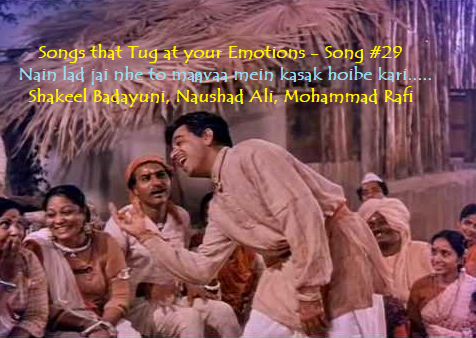
Lyricists are only the real super actors. Before they write , they themselves enact the real drama in their minds . The enactment by actors then may be taken as imitation of the real enactment that gave to the words and there order.
Yes, Jaswant. The actors don’t add emotions of their own in words. Thgese have already been penned by lyricists and dialogue writers.